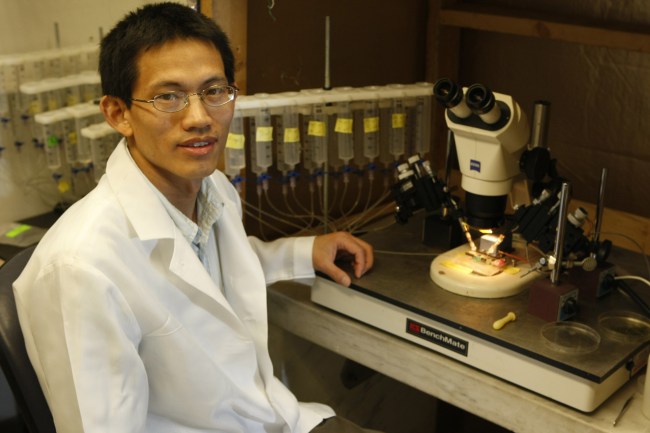
Guirong Wang and colleagues are investigating how mosquitos home in on their targets. (photo by Steve Green)
New anti-malarial project aims to disrupt the mosquito’s heat-seeking ability
When a female malaria mosquito is looking for a “host” for the blood meal that she needs to reproduce, she begins by following the distinctive combination of odors that humans give off.
As she closes in on her target, however, a different sense comes into play: her ability to detect the heat given off by her warm-blooded prey. On final approach she becomes a tiny heat-seeking missile zeroing in on bare patches of skin.
For the last four years, Laurence Zwiebel, Ph.D., professor of Biological Sciences, has headed up a major research effort investigating the mosquito’s sense of smell with the support of a Grand Challenges to Global Health grant from the Bill & Melinda Gates Foundation.
The object of the project is to discover disruptive chemical odorants that can be used as tools to eradicate malaria. Now, the Vanderbilt team has received a second award from the Gates Foundation – a Grand Challenges Explorations grant – to extend their effort to include the female Anopheles mosquito’s heat detection apparatus.
The new departure was the idea of Guirong Wang, senior research associate, who is the principal investigator on the new one-year, $100,000 grant. Although the sense of smell is the mosquito’s primary method for locating prey, its thermal sense plays an extremely important role in its target-acquisition ability.
“The two capabilities work together synergistically to increase the mosquito’s efficiency,” Wang explained. So there is good reason to think that combining small molecules that interfere with the mosquito’s heat detection capability with molecules that disrupt its sense of smell could be particularly effective at reducing its effectiveness as a malaria vector.
The mosquito’s primary sense organ is its antennae, which contain hundreds of thousands of olfactory receptors that respond to different chemical compounds. Recent research has found that its heat-detection sensors are also located on the antennae.
As part of an independent project, Wang discovered that a mosquito version of a gene known to code for a thermal receptor in the fruit fly Drosophila is expressed at the tip of the female Anopheles’ antennae. This provided the information that he needed to apply for the Gates funding.
With the new award, he will begin working full time to identify and characterize the heat receptors on the antennae and then begin exposing them to small molecules to determine which can interfere with their heat sensing ability. Based on the experience in the olfactory project, Wang estimates that they should be able to screen about 10,000 compounds and identify 10 to 20 with disruptive properties by the end of the grant.
If he and his colleagues successfully demonstrate that the approach is feasible, the Gates Foundation will consider giving them a larger, follow-on grant to develop it.













